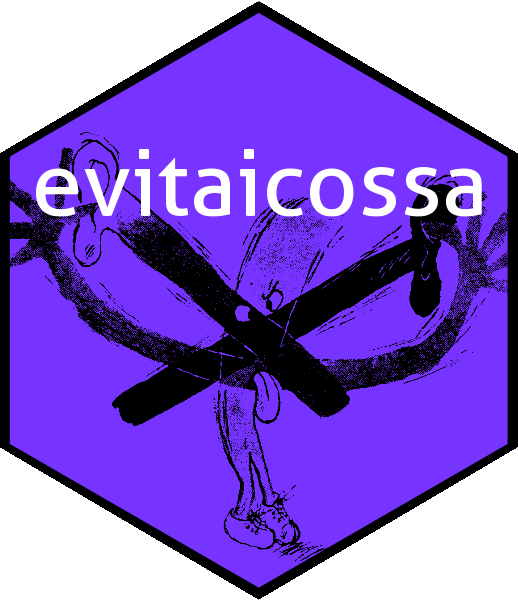An algebra is a vector space equipped with a bilinear product: the vectors may be multiplied. Algebras may be defined over any field but here we use the real numbers. An antiassociative algebra is an algebra in which the usual associativity relation for vector multiplication is replaced by . Antiassociative algebras are nilpotent of nilindex 4: the product of any four vectors is zero. Antiassociative algebras are the direct sum of elements of degree 1,2 and 3 (the antiassociativity condition implies that the degree zero component is trivial, and the nilpotence ensures that components of degree four or above do not exist). Thus the general form of an element of an antiassociative algebra is thus where , , are constants and the are indeterminates.
The evitaicossa package provides some R-centric functionality for working with antiassociative algebras. In an R session, you can install the released version of the package from CRAN with:
# install.packages("evitaicossa") # uncomment to install the package
library("evitaicossa") # loads the package The package includes a single S4 class aaa [for “antiassociative algebra”] and a range of functions to create objects of this class. A good place to start is function raaa(), which creates a random object of class aaa:
(evita <- raaa())
#> free antiassociative algebra element:
#> +1a +3b +2d +3a.b +1c.b +1c.c +1(a.b)a +1(b.b)c +1(b.c)a
(icossa <- raaa())
#> free antiassociative algebra element:
#> +4a +2b +2a.a +2c.c +2d.d +2(b.d)d +1(c.d)a +4(d.b)c
(itna <- raaa())
#> free antiassociative algebra element:
#> +2a +2c +4d +1b.d +2c.b +2c.d +3(b.a)d +3(b.b)c +4(b.c)bAbove, we see objects evita, icossa and itna are random antiassociative algebra elements, with indeterminates a, b, c, d. These objects may be combined with standard arithmetic operations:
evita+icossa
#> free antiassociative algebra element:
#> +5a +5b +2d +2a.a +3a.b +1c.b +3c.c +2d.d +1(a.b)a +1(b.b)c +1(b.c)a +2(b.d)d
#> +1(c.d)a +4(d.b)c
evita*icossa
#> free antiassociative algebra element:
#> +4a.a +2a.b +12b.a +6b.b +8d.a +4d.b -2(a.a)a +12(a.b)a +6(a.b)b -2(a.c)c
#> -2(a.d)d -6(b.a)a -6(b.c)c -6(b.d)d +4(c.b)a +2(c.b)b +4(c.c)a +2(c.c)b
#> -4(d.a)a -4(d.c)c -4(d.d)dIt is possible to verify some of the axioms as follows:
c(
left_distributive = evita*(icossa + itna) == evita*icossa + evita*itna,
right_distributive = (evita + icossa)*itna == evita*itna + icossa*itna,
antiassociative = evita*(icossa*itna) == -(evita*icossa)*itna
)
#> left_distributive right_distributive antiassociative
#> TRUE TRUE TRUEFor further details, see the package vignette
